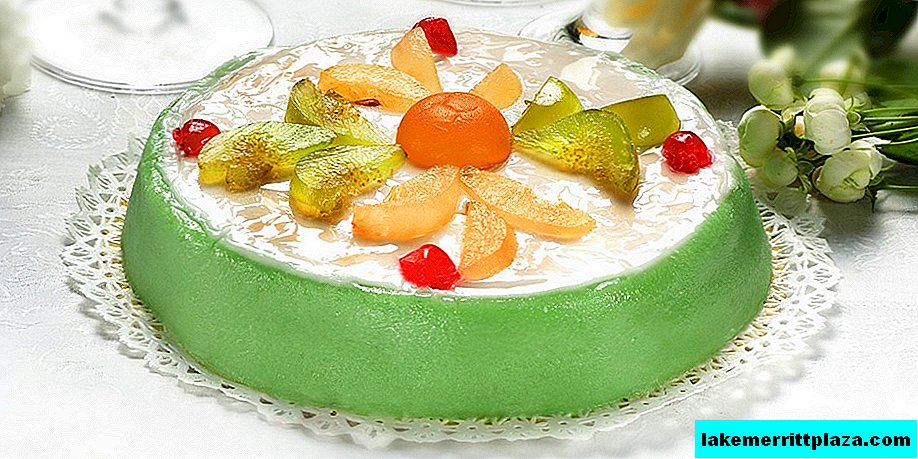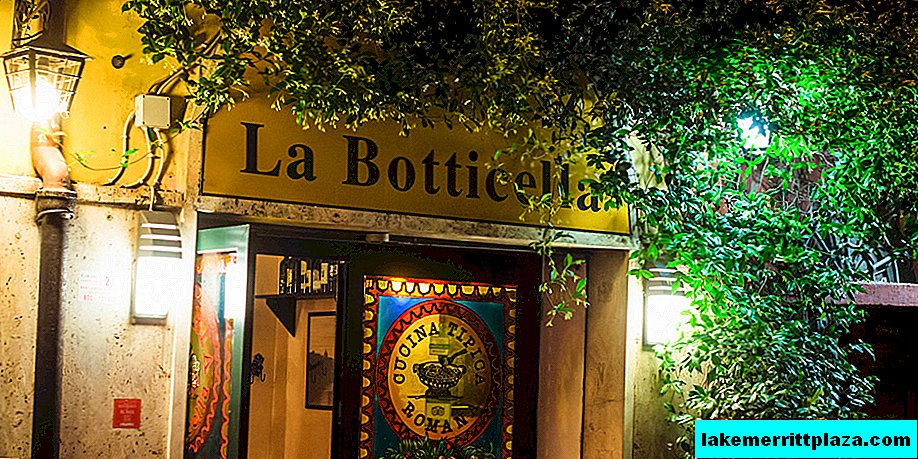The Sicilian Cassata (Cassata Siciliana), perhaps the most famous sweet islet, is a layered cake made of sponge cake soaked in liquor, combined with ricotta, fruit and marzipan. Born in Sicily (Sicilia), cassata has become a traditional Easter dish in all of Italy. Despite the apparent simplicity, a recipe for a unique dessert is in almost every city on the island. But traditional, nevertheless, is considered a cassata from Palermo (Palermo).

Story
Like many dishes with ancient history, the roots of cassata are Sicilian lost in the mists of time. Therefore, the dessert is attributed to different times of birth and the origins of the name, but the homeland remains unchanged.
Some of the written evidence of the Kassata cake dates back to the 15th century. But it is not clear how close the medieval dessert is to today's recipe.
In Sicily, it is customary to consider the 14th century as the time of birth of the dish. Culinary writer Giuliano Bugialli unambiguously ascribes to the name of the cake a Latin origin from the word Caseus, which means "cheese." Sicilian Abbot Angelo Senisio in 1348 mentions “cassata” in the Sicilian dialect dictionary and defines it as a cake and then as ice cream made from cheese or cacio.
In the 14th century Tuscan cookbook there is a record of a "casciata" dish made from cheese and beaten eggs. But he can not be considered the ancestor of the Sicilian cassata, as this is clearly not a sweet cake.
Despite such evidence of the Latin origin of the name, the etymologists Aleppo and Calvaruso consider such conclusions far-fetched. For example, the Sicilian-Italian dictionaries of the XVIII and XIX centuries, the term "cassata" is defined as a small box where sweets are stored (the so-called sweet box).
Most historians agree that the roots of Kassat lie between the 9th and 11th centuries (the Arab period in Sicily). It was the Arabs who brought sugarcane, almonds and some types of citrus to the island. Legend has it that one night an Arab shepherd decided to mix ricotta with sugar and mistakenly put sweet cheese in a bowl in which there was dough intended for a pie. In the morning, the cook baked the contents of the container in the oven. Thus was born the first Sicilian cassata, which has survived to this day in a transformed form.

The earliest mention of this Sicilian cake is a contract from 1409 for the supply of cassate to a Jew named Sadone Misok.
An interesting fact is that in 1574 the diocese of Mazzara del Vallo banned the manufacture of Sicilian cassata in monasteries during Holy Week, because "the nuns preferred to eat cake rather than pray."
The first version of the dessert included only three components: ricotta, sugar and shortbread dough. Later, when the Spaniards brought "culinary innovations" to Sicily, the cooks began to use a biscuit and cover the cake with icing. And after 1600, when a new era in Italian art began, the surface of the cassata began to be decorated with candied fruits and baroque fruits.
Recipe

Sicilian cassata recipe is quite simple, but requires a lot of skills, especially if you are going to decorate it grandly. We will talk about the variations and decorations below, but for now we present to your attention an original recipe for a cake from Palermo.
From kitchen utensils you will need:
- 1 liter filling bowl;
- Blender or sieve;
- Pan with a thick bottom;
- Rolling pin;
- Sharp knife;
- Mixer;
- Biscuit baking dish;
- Cake mold (preferably round);
- Measured dishes.
The whole cooking process consists of several stages.
Filling

For the filling you will need the following ingredients:
- 500 g of ricotta;
- 300 g of sugar;
- 50 g of chocolate drops;
- 1 sachet of vanillin.
Ricotta you can not buy. We wrote about how to cook Italian cheese in our article: "How to make ricotta at home - a recipe with a photo." So, if you cooked fresh cheese, then you must keep it in the refrigerator for at least one night. Add sugar and vanillin to the ricotta and let it brew for about an hour. Grind the mixture with a blender or through a sieve to a smooth, soft consistency and mix it with chocolate drops. The filling is ready and will wait for the remaining parts in the refrigerator.
Marzipan

To make marzipan, you need the components:
- 250 g of almond flour;
- 250 g of granulated sugar;
- 150 g of water;
- Green food coloring.
Put a pot of water on a slow fire, pour sugar into it and heat, stirring constantly. When the syrup begins to thicken, pour almond flour and dye and mix until completely dissolved. Then put the dough on a glossy, moistened surface and let cool slightly. Knead the mass with your hands until it becomes smooth and soft. Roll it with a rolling pin to a thickness of 8 mm and cut into rectangles 6 cm wide and a length equal to the height of the selected shape.
Icing
For glaze, only 2 ingredients are required:
- 150 g of sugar;
- 75 ml. water.
Mix sugar with water and simmer until the mass is viscous and transparent. It is important that the frosting is hot. Therefore, it is necessary to cook it when the cassette is already “assembled”.
Biscuit

Sponge cake dough consists of the following components:
- 75 g of flour;
- 75 g of potato starch;
- 5 eggs;
- 1 sachet of vanillin;
- 150 g of sugar;
- A pinch of salt.
Separate the whites from the yolks in two bowls. Beat with a mixer the yolks with half the sugar until a creamy mass of light yellow color. Then, with another piece of sugar, beat the whites until they are steady peaks. Gently mix both masses, and then sift dry ingredients into them and mix gently. Lubricate the mold with a little oil, sprinkle with flour and pour the dough. Bake in a preheated oven to 180 degrees for 40 minutes. In no case do not open the oven door during baking, otherwise the biscuit may fall. Cool the finished product to room temperature.
Component assembly
The choice of form for the cassette is completely individual. The classic dessert is round, but there are square and polygonal varieties.
So, cut the sponge cake lengthwise into 3 discs. Lightly moisten them with sweet water. Cover the bottom of the mold with one cake, cut the other into rectangles of the same size as the marzipan. Lay out the sides, alternating marzipan with biscuit. Place the filling in the mold and cover with the remaining biscuit disk on top. Leave the dessert for an hour in the refrigerator, then turn the cassette on a plate and pour warm glaze. You can decorate the cooled surface with fresh fruit or candied fruit at your discretion.
Recommendations
The recipe, of course, is voluminous, but simple enough. But simplicity can be slightly spoiled, not taking into account some nuances:
- If the ricotta is too wet, place it on a sieve covered with gauze and leave to drain in the refrigerator overnight. In the morning you will get cheese of the necessary texture.
- It is quite possible not to bake a biscuit, but simply to purchase it in a storeif you doubt your abilities.
- During moisturizing, do not "drown" the biscuit, it should be slightly wet.
- The filling should be slightly leveled, while not strongly pressing.
Calorie content

The classic cassata will bring you joy at one glance at it and endless pleasure when you eat it. But the next day, when you get on the scales in the morning, will be a little less joyful. 100 g of classic dessert contains about 400 kcal, 29% of which are fats, 64% are carbohydrates and 7% are proteins.
But there is good news: cassate contains a large amount of phosphorus and calciumresponsible for the healthy state of bones, teeth and skin. Dessert is also rich in potassium, which is necessary for the cardiovascular system.
Remember, the more the dish acquires additional components, the higher its nutritional value becomes.
Sicilian cassata will be an excellent breakfast at the beginning of a healthy day. It is able to cover 20% of the daily energy requirements.
Cassata in the oven
Cassata in the oven or Cassata al forno is actually the very first version of the dessert.
It lacks marzipan and candied fruit. To prepare it, take a tighter dough than for a biscuit (usually yeast). A cassette case is made of it, which is filled with a filling identical to the Sicilian cake. All this is baked in the oven for about half an hour and sprinkled with icing sugar.
Varieties

Sicilian cassata is an infinitely diverse dessert. You can meet a modest little girl, drenched with ordinary sugar glaze, or lose your head from pompously decorated with candied fruit and pearl beads, a royal royal cake.
There are also a lot of options for impregnating a biscuit. As it can be used as alcoholic beverages (rum, liquor), and fruit juices, or a combination of both.
Variations of the filling are present in almost every city in Sicily. For example, in Catania they prefer a cassette in the oven with pistachio filling. In the commune of Modica, they love to make a dessert with pine nuts, cinnamon or chocolate. In general, you can complement the classic filling with your favorite candied fruits, nuts or spices.

In Sicily, there are unusual options for cassate. One of them is Cassatella Saint Agatha (Cassatella di Sant'Agata), in common people called "virgin breasts". It is made in small sizes in the form of individual portions with a cocktail cherry on top. The shape of the dessert resembles a woman’s breast, which symbolizes the specific agony of St. Agatha. Cassatella is prepared exactly on the day of veneration of this catalytic martyr.
The second extraordinary recipe for kassat can boast the city of Messina (Messina). His chefs replaced the ricotta filling with Italian ice cream (gelato). This dessert is less sweet than the classic version.
A review of the stunning islet is complete. You know, cassata is not just a cake, it is like the sea. It’s not enough to just hear about it, it’s not enough just to see it, you need to immerse yourself in it, taste and enjoy unforgettable emotions. Live vibrantly, truly love, travel boldly and remember how the great Vigneto Puhini said: "He who eats Kassata in the morning, he acts wisely. Param-tara, tara-param, then it is morning!"








